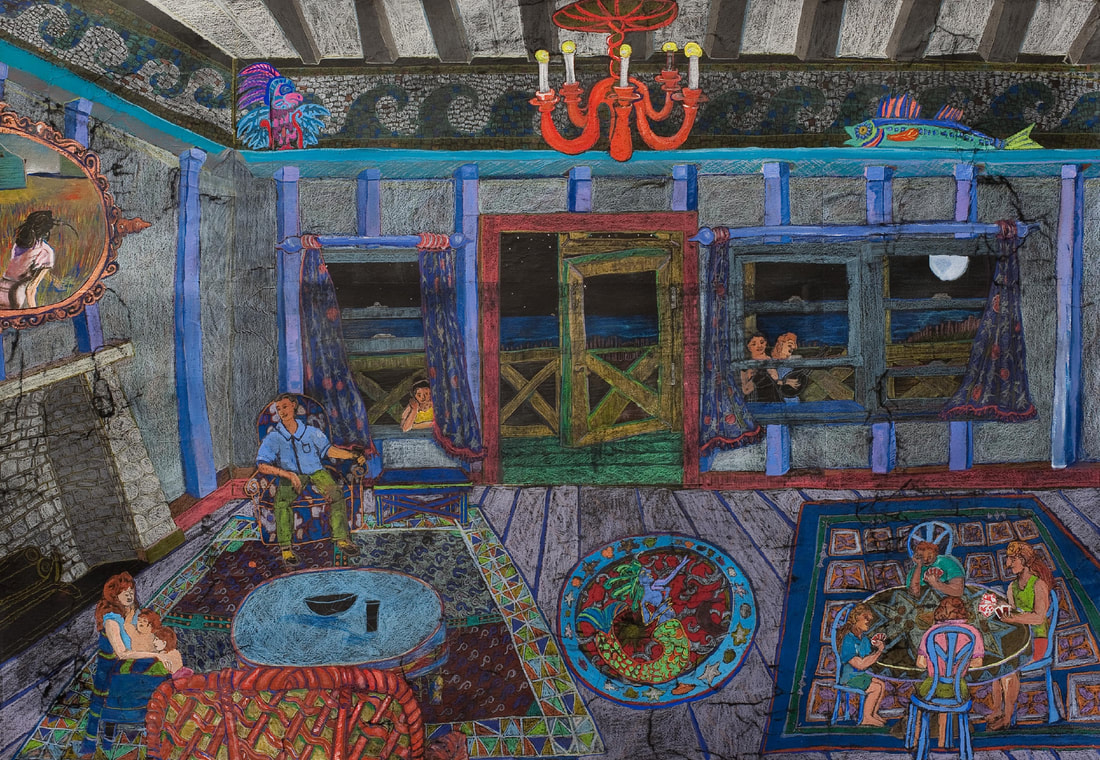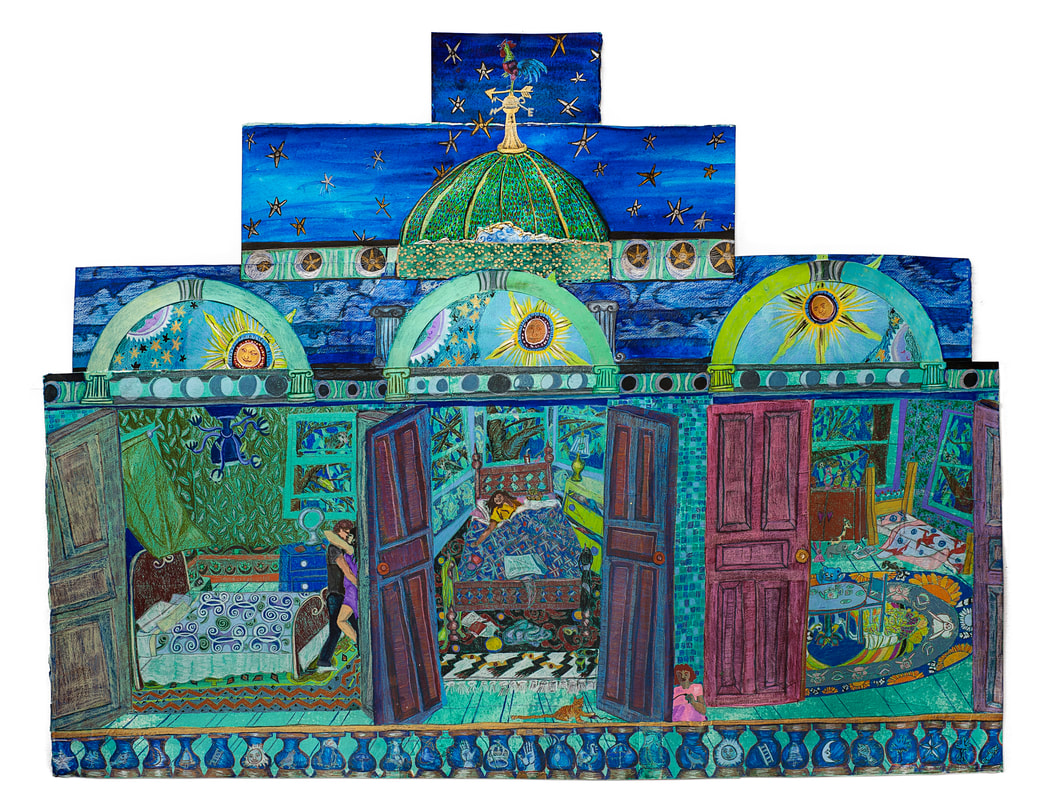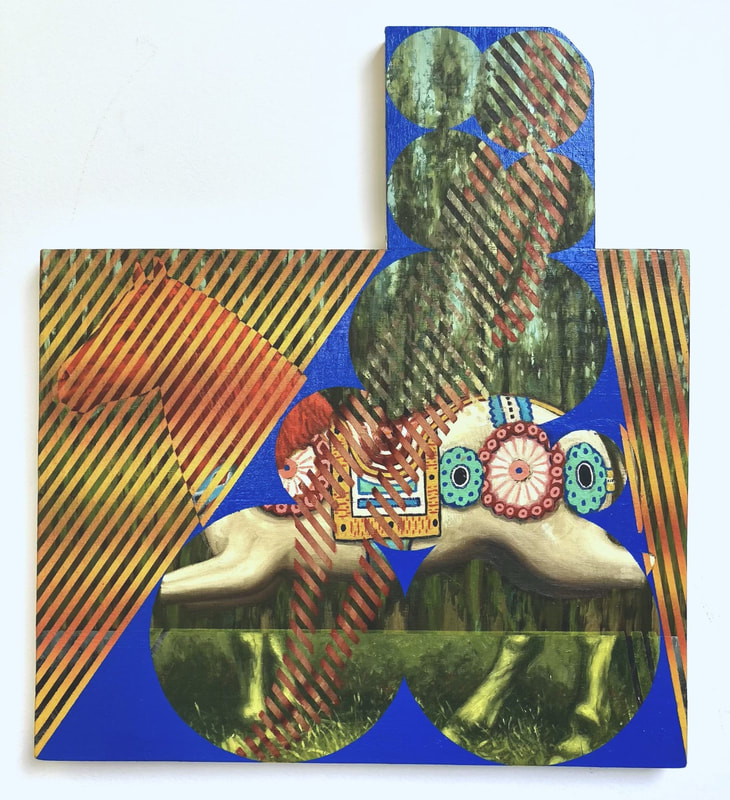Zhaira Costiniano There is a unique, idealistic quality to the work you create. Your pieces invite the viewer into decades of intimate memories from both your youth and adult life. Can you walk me through why you have consciously chosen to give a romanticized permanence to these moments?
Carroll Swenson-Roberts My images are almost always of the idea of home, whether home is a reconfigured memory or an interior that revolves around the figures I inhabit my work with. The interior spaces depict a way of being at home in the world. I am going back to a place/time/memory that I have been before, improving on it, and making them a comfortable memory space to be in . The short answer is: It makes me happy. I really enjoy going to those places as I work on the narrative of the piece.
Carroll Swenson-Roberts My images are almost always of the idea of home, whether home is a reconfigured memory or an interior that revolves around the figures I inhabit my work with. The interior spaces depict a way of being at home in the world. I am going back to a place/time/memory that I have been before, improving on it, and making them a comfortable memory space to be in . The short answer is: It makes me happy. I really enjoy going to those places as I work on the narrative of the piece.
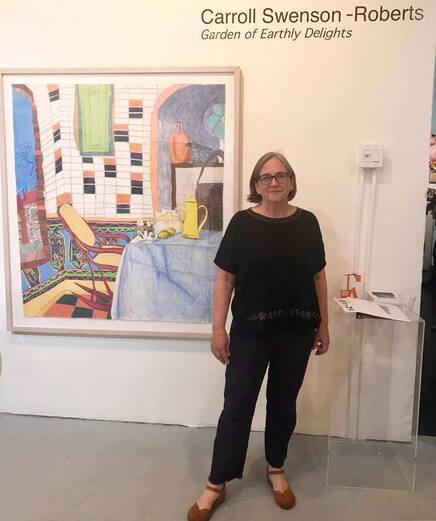 Carroll Swenson-Roberts at opening reception of her exhibition "Garden of Earthly Delights" at Ro2 Art, 2019
Carroll Swenson-Roberts at opening reception of her exhibition "Garden of Earthly Delights" at Ro2 Art, 2019
ZC Would it be safe to say it's a therapeutic practice?
CSR I don’t know about that. I have always done these drawings. I am sure they keep me sane and healthy to a certain degree. I always think of them as my best means of communication.
If I can share my idea of an ordinary life through the materials I use and images I draw and paint and someone recognizes that world as familiar then I think a communication of understanding has taken place. That is always my hope.
ZC I see. So is home a concrete place for you, or does it mean a lot of things?
CSR Both. Home is concrete. I do draw from every place I have ever called home. I sometimes refer to this series as the domestic series. That doesn’t sound important but for me the idea of family and home and the everyday are the most important.
Also home is the feeling of being comfortable in the world, and with oneself, which I think is very hard and a worthy goal\ideal.
CSR I don’t know about that. I have always done these drawings. I am sure they keep me sane and healthy to a certain degree. I always think of them as my best means of communication.
If I can share my idea of an ordinary life through the materials I use and images I draw and paint and someone recognizes that world as familiar then I think a communication of understanding has taken place. That is always my hope.
ZC I see. So is home a concrete place for you, or does it mean a lot of things?
CSR Both. Home is concrete. I do draw from every place I have ever called home. I sometimes refer to this series as the domestic series. That doesn’t sound important but for me the idea of family and home and the everyday are the most important.
Also home is the feeling of being comfortable in the world, and with oneself, which I think is very hard and a worthy goal\ideal.
ZC There's a lot of things I'd like to expand on with that. First off, you mentioned your domestic series. Is this a new series, or is it a continuation of the work you have been producing.
CSR The Domestic series is a continuation of work I’ve been doing for the last 30 years. It is how I think of almost all my work. In the Domestic series I have a subset of series. They were represented in the shows Temple of Small Wishes, Memory Palace, and Garden of Earthly Delights.
CSR The Domestic series is a continuation of work I’ve been doing for the last 30 years. It is how I think of almost all my work. In the Domestic series I have a subset of series. They were represented in the shows Temple of Small Wishes, Memory Palace, and Garden of Earthly Delights.
ZC It gives your whole body of work a compelling narrative to it.
CSR The narrative concerns the surprise of growing up, and growing up continues your whole life. I think surprise comes from the passage of time. When I was young, my art was sometimes about looking ahead. I would think "What’s going to happen next?" As I am older, my art sometimes comes from nostalgia. I think "I can’t believe that happened," or "I can’t believe that is over," and the art records those time. All through my career, young and old, my art has been about examining and noticing the moments that make up life.
CSR The narrative concerns the surprise of growing up, and growing up continues your whole life. I think surprise comes from the passage of time. When I was young, my art was sometimes about looking ahead. I would think "What’s going to happen next?" As I am older, my art sometimes comes from nostalgia. I think "I can’t believe that happened," or "I can’t believe that is over," and the art records those time. All through my career, young and old, my art has been about examining and noticing the moments that make up life.

ZC You often include your family in your pieces. Do you find yourself using art to communicate with them sometimes?
CSR No. They almost always know what I am drawing about no matter what. I think we read each other’s minds. I grew up in a wonderful bubble of a very large and close family. I love to share them and our shared family stories.
ZC Your stories of your sisters attract me the most. They're funny and chaotic and capture sisterhood quite well.
CSR No. They almost always know what I am drawing about no matter what. I think we read each other’s minds. I grew up in a wonderful bubble of a very large and close family. I love to share them and our shared family stories.
ZC Your stories of your sisters attract me the most. They're funny and chaotic and capture sisterhood quite well.
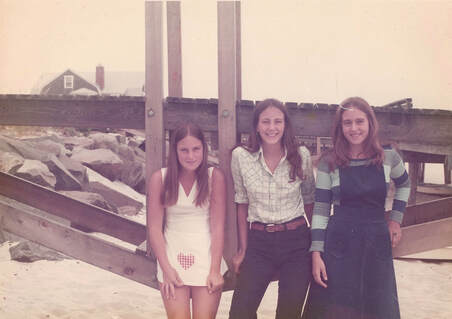
CSR My sisters and I are very close. We do have a loving, funny and sometimes chaotic bond. They are two of the most important relationships in my life. I am the middle sister. There is nothing more fun than spending a month or two drawing on my family, especially my sister.
ZC The piece that comes to mind when it comes to your sisters is Temple of Growing Up. There are a lot of religious art historical pieces referenced in it, as well as the other pieces in this sub-series.
CSR That is one of my mother pieces (like the mother starter in sourdough). It started with the memory of the hallway where the three sisters bedrooms were. It was drawn on 4 pieces on paper, which was later mounted on a wood panel made in the shape of a ziggurat.
ZC The piece that comes to mind when it comes to your sisters is Temple of Growing Up. There are a lot of religious art historical pieces referenced in it, as well as the other pieces in this sub-series.
CSR That is one of my mother pieces (like the mother starter in sourdough). It started with the memory of the hallway where the three sisters bedrooms were. It was drawn on 4 pieces on paper, which was later mounted on a wood panel made in the shape of a ziggurat.
The first piece was the bottom piece with the three bedrooms. My family was Irish Catholic (except for my father but he converted when he was in his 70’s). The only thing I liked about going to church was the art. I always loved the triptychs in the cathedrals and my art history books. So three sisters, three rooms seemed like a fun triptych to work on.
After I got finished with the bottom piece, I felt there was more to this particular story. I added the piece with the three arches, sun, and the moon: Night and day, light and dark, Cycles of the moon. It still did not feel complete, so I added the dome and then the rooster on top. While working on this piece, I was looking at the Limbourg Brothers “Book of Days” as well as other illuminated prayer books from the Medieval period. The Temple of Growing Up is heavily influenced by the images both decorative and symbolic from the illuminated texts.
I never know when I begin a piece where it will end up. The narrative unfolds as I work on it. I think that is true of all my work. I think that is also a true for a lot of artist. This piece was the last in the Memory Palace show and the first in The Temple of Small Wishes show. It is also the first piece where the image is on a wood panel.
After I got finished with the bottom piece, I felt there was more to this particular story. I added the piece with the three arches, sun, and the moon: Night and day, light and dark, Cycles of the moon. It still did not feel complete, so I added the dome and then the rooster on top. While working on this piece, I was looking at the Limbourg Brothers “Book of Days” as well as other illuminated prayer books from the Medieval period. The Temple of Growing Up is heavily influenced by the images both decorative and symbolic from the illuminated texts.
I never know when I begin a piece where it will end up. The narrative unfolds as I work on it. I think that is true of all my work. I think that is also a true for a lot of artist. This piece was the last in the Memory Palace show and the first in The Temple of Small Wishes show. It is also the first piece where the image is on a wood panel.
ZC Do you see yourself creating more pieces with medieval/religious references, or was it a specific exploration for your show Temples of Small Wishes?
CSR The answer to both of those questions is yes. The structure and space in most of my narrative work is heavily influenced by medieval art.
The first show I had at Ro2 Temple of Small Wishes was specifically based on the "Book of Days". The wood panels were all shaped like temples. The last show I had at Ro2 was titled The Garden of Earthly Delights after the Bosch painting (That painting was the first painting I was totally fascinated with).
I do however use other art historical references also. I love to peruse art catalogues and books as well as old photographs. I recently have spent time in local museums sketching the works on the walls. I have a drawing on my desk right now with the Botticelli’s Primavera ladies. It's not a medieval painting, but it has all the decoration and symbolism I love.
CSR The answer to both of those questions is yes. The structure and space in most of my narrative work is heavily influenced by medieval art.
The first show I had at Ro2 Temple of Small Wishes was specifically based on the "Book of Days". The wood panels were all shaped like temples. The last show I had at Ro2 was titled The Garden of Earthly Delights after the Bosch painting (That painting was the first painting I was totally fascinated with).
I do however use other art historical references also. I love to peruse art catalogues and books as well as old photographs. I recently have spent time in local museums sketching the works on the walls. I have a drawing on my desk right now with the Botticelli’s Primavera ladies. It's not a medieval painting, but it has all the decoration and symbolism I love.
|
ZC Speaking of the now, how are you doing during the quarantine? These are such unprecedented and uncertain times. Do you find that the current circumstances are changing the tone of your work, or are you still able to stay optimistic?
CSR It’s horrible.Who would have ever guessed we would all end up in a sci-fi movie. It does affect my work. The anger and anxiety hasn’t shown up yet. Longing for connection is what I see in my current art of the last two months. The Primavera ladies has a bit of a sarcastic feel, but I’ll see where it ends up. Barbara Horlander had the wonderful idea of exchanging art cards with other artist. That has been a joy and helps with the feeling of isolation and monotony . I actually am working on a piece that is on the wood panels again. It’s starting with a hug and a big tree. ZC A HUG! What a concept these days. Communication is big for you, so do you find comfort in your work right now? Since it has been so difficult to physically be present and communicate those emotions? CSR Yes, definitely. Comfort and focus. My work always helps me figure out where I am. |

